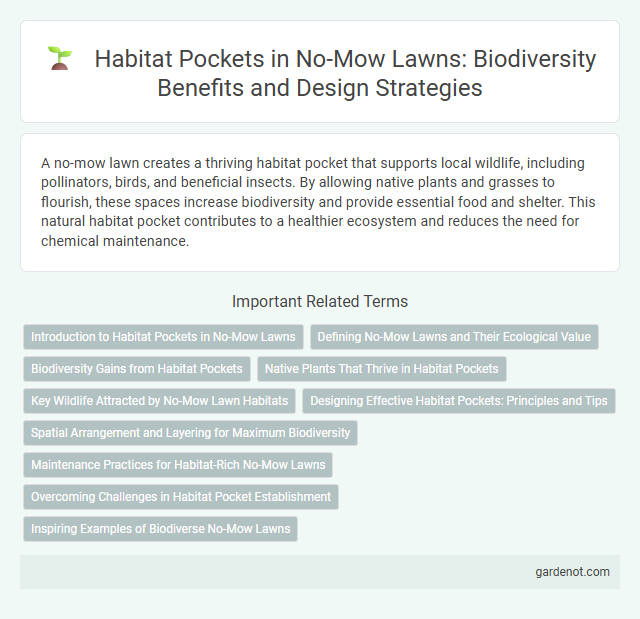A no-mow lawn creates a thriving habitat pocket that supports local wildlife, including pollinators, birds, and beneficial insects. By allowing native plants and grasses to flourish, these spaces increase biodiversity and provide essential food and shelter. This natural habitat pocket contributes to a healthier ecosystem and reduces the need for chemical maintenance.
Introduction to Habitat Pockets in No-Mow Lawns
Habitat pockets in no-mow lawns create essential microenvironments that support biodiversity by providing shelter and food for pollinators, insects, and small wildlife. These pockets often contain native wildflowers and grasses, which thrive when mowing is minimized, promoting healthier ecosystems and improved soil health. Integrating habitat pockets into no-mow lawns enhances ecological balance and contributes to sustainable landscape practices.
Defining No-Mow Lawns and Their Ecological Value
No-mow lawns are areas intentionally left unmowed to promote native plant growth and support biodiversity, creating crucial habitats for pollinators, birds, and other wildlife. Habitat pockets within these no-mow zones increase local ecological diversity by providing shelter and food sources that conventional lawns lack. This sustainable landscaping approach enhances soil health, conserves water, and reduces carbon emissions compared to traditional mowing practices.
Biodiversity Gains from Habitat Pockets
Habitat pockets within no-mow lawns significantly enhance urban biodiversity by providing essential microhabitats for pollinators, insects, and small wildlife. These small, undisturbed patches of native vegetation promote diverse species interactions and improve soil health through increased organic matter. Supporting habitat pockets reduces the need for chemical inputs, fostering a sustainable and resilient ecosystem in suburban and urban green spaces.
Native Plants That Thrive in Habitat Pockets
Native plants such as purple coneflower, black-eyed Susan, and milkweed thrive in habitat pockets due to their adaptability to minimal mowing and nutrient-poor soils. These species support local pollinators like bees and butterflies, enhancing biodiversity within no-mow lawns. Their deep root systems improve soil health and reduce erosion, making habitat pockets a sustainable landscaping choice.
Key Wildlife Attracted by No-Mow Lawn Habitats
No-mow lawn habitats create rich environments that attract pollinators such as native bees and butterflies, essential for ecosystem health and plant reproduction. These lawns provide critical shelter and nesting sites for ground-dwelling birds and small mammals, promoting greater biodiversity. Native wildflowers and grasses found in no-mow areas support a robust food web by sustaining insect populations vital to local predators.
Designing Effective Habitat Pockets: Principles and Tips
Designing effective habitat pockets requires incorporating native plants that provide food, shelter, and breeding grounds for local wildlife, promoting biodiversity within a no-mow lawn. Selecting a variety of plant species with staggered blooming periods ensures continuous resources for pollinators and birds throughout the seasons. Integrating features such as layered vegetation, natural mulch, and minimal disturbance enhances habitat complexity and supports ecosystem resilience.
Spatial Arrangement and Layering for Maximum Biodiversity
Habitat pockets in no-mow lawns utilize strategic spatial arrangement and layering to maximize biodiversity by creating diverse microhabitats that support insects, birds, and small mammals. Vertical layering with ground covers, herbaceous plants, and native shrubs provides varied food sources and shelter, enhancing ecological complexity and resilience. Optimizing plant density and zonation fosters pollinator pathways and niche differentiation, promoting sustainable ecosystem services within urban green spaces.
Maintenance Practices for Habitat-Rich No-Mow Lawns
Habitat pocket no-mow lawns require minimal intervention, focusing on native plant species that support local wildlife and promote biodiversity. Maintenance practices prioritize periodic assessments for invasive species removal and selective pruning to enhance plant health without disrupting habitat structures. Regular soil health monitoring ensures nutrient balance while avoiding chemical fertilizers to maintain an eco-friendly environment conducive to pollinators and beneficial insects.
Overcoming Challenges in Habitat Pocket Establishment
Habitat pocket establishment often faces challenges such as soil compaction, limited native plant species, and inconsistent maintenance practices. Implementing no-mow lawn techniques reduces soil disturbance and promotes biodiversity by allowing native plants to thrive, creating a stable environment for wildlife. Proper site preparation and adaptive management strategies enhance the success rate of habitat pockets, ensuring sustainable ecosystem development.
Inspiring Examples of Biodiverse No-Mow Lawns
Habitat Pocket showcases inspiring examples of biodiverse no-mow lawns featuring native wildflowers and grasses that support pollinators like bees and butterflies. These no-mow habitats reduce maintenance while enhancing urban biodiversity and promoting healthy ecosystems. Incorporating diverse plant species creates vibrant, resilient landscapes that attract birds, insects, and other wildlife year-round.
Habitat pocket Infographic

 gardenot.com
gardenot.com